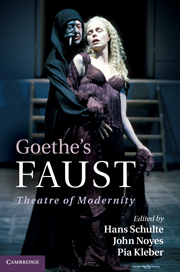Book contents
- Frontmatter
- Contents
- List of illustrations
- List of contributors
- Preface
- List of abbreviations
- Introduction
- PART I MODERNITY
- 1 Faust – today
- 2 Mephisto and the modernization of evil
- 3 Mephisto is the devil – or is he?
- 4 ‘Schwankende Gestalten’: virtuality in Goethe's Faust
- 5 Amnesia and anamnesis in Goethe's Faust
- 6 Magicians of modernity: Cagliostro and Saint-Simon in Goethe's Faust II
- 7 The blind Faust
- 8 From Faust to Harry Potter: discourses of the centaurs
- 9 Mistra and the Peloponnese in Goethe's Faust II
- 10 Goethe and the grotesque: the ‘Classical Walpurgis Night’
- 11 Re-defining classicism: antiquity in Faust II under the sign of the Medusa
- 12 Diabolical entrapment: Mephisto, the angels and the homoerotic in Goethe's Faust II
- PART II THEATRE
- Select bibliography
- Index
- References
6 - Magicians of modernity: Cagliostro and Saint-Simon in Goethe's Faust II
Published online by Cambridge University Press: 01 June 2011
- Frontmatter
- Contents
- List of illustrations
- List of contributors
- Preface
- List of abbreviations
- Introduction
- PART I MODERNITY
- 1 Faust – today
- 2 Mephisto and the modernization of evil
- 3 Mephisto is the devil – or is he?
- 4 ‘Schwankende Gestalten’: virtuality in Goethe's Faust
- 5 Amnesia and anamnesis in Goethe's Faust
- 6 Magicians of modernity: Cagliostro and Saint-Simon in Goethe's Faust II
- 7 The blind Faust
- 8 From Faust to Harry Potter: discourses of the centaurs
- 9 Mistra and the Peloponnese in Goethe's Faust II
- 10 Goethe and the grotesque: the ‘Classical Walpurgis Night’
- 11 Re-defining classicism: antiquity in Faust II under the sign of the Medusa
- 12 Diabolical entrapment: Mephisto, the angels and the homoerotic in Goethe's Faust II
- PART II THEATRE
- Select bibliography
- Index
- References
Summary
To be sure, Goethe stated repeatedly that what appears in the second part of Faust is ‘a higher, more spacious, brighter, more dispassionate world’, and that one must ‘lead a man like him through more worthy circumstances, in higher regions’. Yet occasionally his intention also admits of more apprehensive tones: ‘There are still a number of magnificent, real and fantastical delusions on earth, in which the poor human, were he to lose himself in them, would experience something nobler, more dignified and higher, than he ever does in the first, common part. Our friend Faust should also have to struggle through these.’ And to this Goethe adds that ‘in the world's daylight, it would look like a pasquinade’.
Those who cling decidedly to the ‘higher regions’, like Max Kommerell, Dorothea Hölscher-Lohmeyer or Wilhelm Emrich, run up against the great entelechy and its spheres of being, the survey, if possible, of cosmic world-regions, primordial ur-phenomena and histories of being – and tend towards a monumental interpretation of Faust, beyond all morality. Those who, on the other hand, keep in mind the ‘real and fantastical delusions on earth’ will retrieve the Faust of the second part, too, from an ontological, ur-phenomenal dimension and expose him to the ‘world's daylight’. The Emperor plot of Acts 1 and 4, as well as the land appropriation venture in the fifth act, are then recognizable as a ‘poetic-symbolic representation of modern existence’, as a more or less systematic sequence of historical-political phenomena, in which ‘symphronistically’ – to use Goethe's expression from the Journeyman Years – the German late Middle Ages are synthesized with the modern present.
- Type
- Chapter
- Information
- Goethe's FaustTheatre of Modernity, pp. 78 - 93Publisher: Cambridge University PressPrint publication year: 2011



